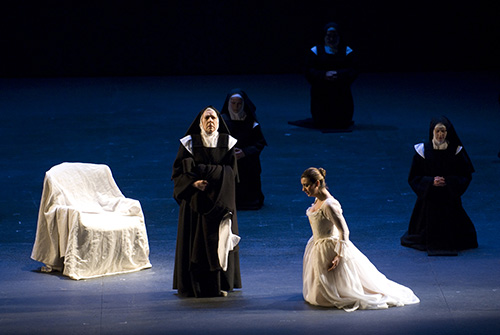-
The Carmélite Nuns, Remembered.
By Danielle D'OrnellasPosted in 2012/2013by Claudine Domingue, Director of Public Relations

For many people, the final scene of Poulenc’s opera Dialogues des Carmélites is one that they will never forget.
The emotional impact as each nun goes to her death singing the "Salve Regina" is heightened by the realization that this opera is based on true events.
On July 17, 1794, 16 members of the order of Carmel in Campiègne, France, were executed by guillotine. They included 11 nuns, three lay sisters, and two novices. Their names were as follows:
Prioress Madeleine-Claudine Ledoine (Mother Teresa of St. Augustine), 1752 – 1794
[READ MORE]
Marie-Anne Brideau (Mother St. Louis), 1752 – 1794
Marie-Anne Piedcourt (Sister of Jesus Crucified), 1715 – 1794
Anne-Marie-Madeleine Thouret (Sister Charlotte of the Resurrection), 1715 – 1794
Marie-Antoinette Hanisset (Sister Teresa of the Holy Heart of Mary), 1740 – 1794
Marie-Françoise Gabrielle de Croissy (Mother Henriette of Jesus), 1745 – 1794
Marie-Gabrielle Trézel (Sister Teresa of St. Ignatius), 1743 – 1794
Rose-Chrétien de la Neuville (Sister Julia Louisa of Jesus), 1741 – 1794
Anne Petras (Sister Mary Henrietta of Providence), 1760 – 1794
Marie-Claude Cyprienne (Sister Euphrasia of the Immaculate Conception), 1736 – 1794
Marie-Geneviève Meunier (Sister Constance), 1765 – 1794
Angélique Roussel (Sister Mary of the Holy Ghost), 1742 – 1794
Marie Dufour (Sister St. Martha), 1742 – 1794
Julie Vérolot (Sister St. Francis Xavier), 1764 – 1794
Catherine Soiron, 1742 – 1794
Thérèse Soiron, 1748 – 1794 -
Behind the Scenes of Dialogues des Carmélites
By Danielle D'Ornellas Posted in 2012/2013 -
Introduction to Dialogues des Carmélites
By Danielle D'OrnellasPosted in 2012/2013
Dialogues des Carmélites
What's it all about?
In 1794, sixteen members of the members of the Carmel of Compiègne (also known as the Martyrs of Compiègne) were felled by the guillotine as the Reign of Terror swept through post-revolutionary France. The women refused to put away their habits and paid with their lives, but despite their death sentence, their faith prevailed. The women were remembered for renewing their vows and singing as they approached the scaffold.
137 years later, Gertrud von Le Fort released a novella titled Die Letzte am Schafott ("The Last on the Scaffold") and two decades later, Francis Poulenc's opera about the doomed order debuted. The book and subsequently the opera was based on a surviving nun's recollection of the events, told through the perspective of a fictional heroine which she based on herself. The character? The timid and uncertain noblewoman, Blanche de la Force.
Not the strongest of characters at the outset, Blanche is a meek woman who is terrified by the uprising of the French revolutionaries. After one particularly frightening swarming by a local mob, she announces to her family that she wants to become a nun in order to escape the harsh world outside. But with the Reign of Terror spreading across the French countryside, the struggles Blanche will eventually face in the abbey come to test her strength, character and faith in ways that the outside world never could. When the executioners come to call, on which side of the scaffold will she fall?
[READ MORE]
